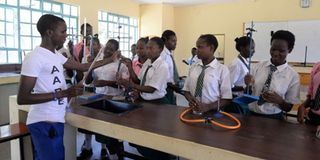Unesco, UN Women decry girls' low uptake of STEM courses

Students of Nyiro Girls Secondary School in Samburu County in the school laboratory during a science practical lesson. UN Women and Unesco have raised the red flag over the few number of girls in the STEM field.
What you need to know:
- Unesco and UN Women have noted that statistics, across the globe, on the gender gap in science need urgent attention.
- The two said efforts to close these gender gaps in science, and address the norms and stereotypes that create and preserve expectations of limited career paths for girls, must be up-scaled.
- They are committed, together with their partners, to prioritize gender equality in all aspects of their work.
Two UN bodies have raised the red flag over the few number of girls in the Science, Technology, Engineering and Math (STEM) field.
The United Nations Educational, Scientific and Cultural Organization (Unesco) and UN Women in a joint statement, noted that statistics, across the globe, on the gender gap in science need urgent attention.
In their statement to mark International Day of Women and Girls in Science, Unesco Director General Audrey Azoulay and UN Women Executive Director Phumzile Mlambo-Ngcuka indicated the need to address gender stereotypes impeding girls from taking sciences.
Unesco’s latest Science Report shows that only 33 per cent of researchers are women, despite the fact that they represent 45 and 55 per cent of students at the Bachelor’s and Master’s levels of study respectively, and 44 per cent of those enrolled in PhD programs.
Gender gaps
The two officials said efforts to close these gender gaps in science, and address the norms and stereotypes that create and preserve expectations of limited career paths for girls, must be up-scaled.
The urgent task they added, is to deal with women’s underrepresentation in areas critical to the future of work such as digital fields where only three per cent of female students in higher education choose information and communication technologies, and renewable energy.
“To be truly transformative, gender equality policies and programs need to eliminate gender stereotypes through education, change social norms, promote positive role models of women scientists and build awareness at the highest levels of decision-making,” they said.
They underscored the need to ensure women and girls participate in Stem fields and are empowered to lead and innovate, and be supported by workplace policies and cultures that ensure their safety, consider their needs as parents, and incentivize them to advance in these careers.
Equal rights
“We need science, and science needs women. This is not only about making a commitment to equal rights; it is also about making science more open, diverse and efficient,” they said.
The two said they are committed, together with their partners, to prioritize gender equality in all aspects of their work.
Unesco, in line with its two global priorities, Africa and gender equality, has been active on the African continent, accompanying girls with online mentoring programs in Kenya and providing school laboratories with micro science kits in the Democratic Republic of the Congo.
According to admission trends released by the Kenya Universities and Colleges Central Placement Service (KUCCPS) last year, science courses like medicine, engineering, pharmacy and architecture among others, remain a no go zone for most girls.
The report indicates that between 2014 and 2019, male students taking engineering students ranged between 76 and 82 per cent.
Health science
This is compared to the admission of girls in the same courses, which partly rose from 18 to 24 per cent in the same period.
“The gap has been gradually decreasing from 2014, when it was 82 per cent male against 18 per cent female. However, a major disparity remains of 76 per cent male against 24 per cent female,” the report said in part.
In relation to health sciences like medicine, nursing and pharmacy, male students the report says, are still much ahead of their female counterparts.
Between 2014 and 2017, for example, the report shows there was a slow growth in the number of female students enrolling for the health science courses.
However, between 2017 and 2018, there was a rise in female enrolment in health science courses, which rose from 31 per cent to 48 per cent before again going down to 43 per cent in 2019.
The report titled Women and Higher Education: Gender Trends in Higher Education in Kenya (Enrolment andFields of Study) reveals thathistorically, the gender representation in university admissions in the country has been in favour of the males.





